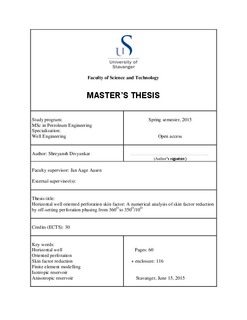| dc.contributor.author | Divyankar, Shreyansh | |
| dc.date.accessioned | 2015-09-22T10:53:53Z | |
| dc.date.available | 2015-09-22T10:53:53Z | |
| dc.date.issued | 2015-06-15 | |
| dc.identifier.uri | http://hdl.handle.net/11250/301130 | |
| dc.description | Master's thesis in Petroleum engineering | nb_NO |
| dc.description.abstract | Formation damage has been a major topic of research and cased and perforated skin factor quantification has received significant attention which has resulted in some truly remarkable publications. The inherent importance of the skin factor in analysing completion efficiency makes it a relevant topic of research and hence this thesis work was undertaken to better understand the effects of orienting the perforations from 360O to 350O/10O on the perforation skin factor.
One of the practical reasons for off-setting the perforations is to provide more space for explosives and hence achieve deeper formation penetration. However, as shown in this work though numerical methods, orienting the perforations has additional significant effects in terms of perforation skin factor reduction in horizontal wells. This reduction effect is observed in both isotropic and anisotropic reservoir settings and is more pronounced for configurations involving smaller diameter boreholes and shorter perforation penetration.
Detailed survey of pertinent literature which forms the foundation of cased and perforated skin factor analysis is presented at the outset and this is used for establishing the theoretical basis for analysing the results obtained from finite element modeling. The results from the finite element modeling are presented subsequently and the same is used to derive conclusions regarding the perforation skin factor reduction effect due to off-setting the perforations. Recommendations for refining the work and future possibilities for expanding the results presented herein are also included. Details of the finite element modeling procedure are presented in a comprehensive manner for the interested reader.
As a part of the thesis work, detailed numerical simulation runs were carried out for three borehole sizes, wherein each borehole size was assigned three different values of perforation tunnel length. Three different types of reservoir setting were applied to study the behaviour of perforation skin factor, depending on the ratio of horizontal to vertical permeability. A total of fifty-four (54) simulation cases were rigourously developed and the output results from all these cases are presented in appendices. | nb_NO |
| dc.language.iso | eng | nb_NO |
| dc.publisher | University of Stavanger, Norway | nb_NO |
| dc.relation.ispartofseries | Masteroppgave/UIS-TN-IPT/2015; | |
| dc.subject | petroleumsteknologi | nb_NO |
| dc.subject | petroleum engineering | nb_NO |
| dc.subject | petroleumsteknologi | nb_NO |
| dc.subject | boreteknologi | nb_NO |
| dc.subject | horizontal well | nb_NO |
| dc.subject | oriented perforation | nb_NO |
| dc.subject | skin factor reduction | nb_NO |
| dc.subject | finite element modelling | nb_NO |
| dc.subject | isotropic reservoir | nb_NO |
| dc.subject | anisotropic reservoir | nb_NO |
| dc.title | Horizontal well oriented perforation skin factor: A numerical analysis of skin factor reduction by off-setting perforation phasing from 360 degree to 350/10 degree | nb_NO |
| dc.type | Master thesis | nb_NO |
| dc.subject.nsi | VDP::Technology: 500::Rock and petroleum disciplines: 510::Petroleum engineering: 512 | nb_NO |
